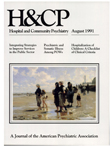A Checklist of Hospitalization Criteria for Use With Children
Abstract
Each year in the U.S. more than 130,000 children are hospitalized for psychiatric reasons. The decision to hospitalize a child is based on a complex set of factors. In this study, a 12-item checklist of criteria for hospitalization adapted by the authors was tested for its ability to predict hospitalization in a cohort of 389 children between the ages of two and 12 who were evaluated for either inpatient or outpatient treatment. Eighty-seven (22 percent) of the children were subsequently hospitalized. In 95 percent of the cases, the checklist was able to correctly predict whether the patient was hospitalized. A shorter checklist of six items was also able to predict the subsequent form of treatment in 95 percent of the cases. Although such checklists cannot take the place of informed clinical decisions, they can serve as a guide to decision making, especially for inexperienced mental health workers, and as a tool for utilization review when treatment decisions are questioned.
Access content
To read the fulltext, please use one of the options below to sign in or purchase access.- Personal login
- Institutional Login
- Sign in via OpenAthens
- Register for access
-
Please login/register if you wish to pair your device and check access availability.
Not a subscriber?
PsychiatryOnline subscription options offer access to the DSM-5 library, books, journals, CME, and patient resources. This all-in-one virtual library provides psychiatrists and mental health professionals with key resources for diagnosis, treatment, research, and professional development.
Need more help? PsychiatryOnline Customer Service may be reached by emailing [email protected] or by calling 800-368-5777 (in the U.S.) or 703-907-7322 (outside the U.S.).



